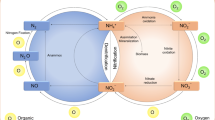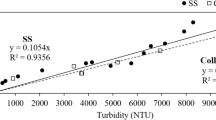Abstract
The pollution caused by wet weather overflow in urban drainage systems is a main factor causing blackening an odorization of urban rivers. The conventional overflow treatment based on coagulation/flocculation in terminal drainage systems requires relatively large space and long retention time demand that makes it not applicable in crowded urban drainage systems or under heavy rains. On-site coagulation/flocculation in terminal drainage pipes was proposed in this study which was aimed to transfer the coagulation/flocculation process to the inside of pipes at the terminal drainage system to save space and reduce the retention time of the coagulation/flocculation process. The optimized dose of chemicals was studied first which was 80 mg/L of coagulant and 0.8 mg/L of flocculant. Settling for only 5 min can remove most of the pollutants at 406.5 m of transmission distance. In addition, the relation of wet weather overflow rate and concentration of pollution load on the on-site coagulation/flocculation process was investigated, which indicated that high removal of pollutant was gained at a large range of flow velocity and pollutant concentration. Finally, the study confirmed electric neutralization, bridging, and net capture as the major mechanisms in this process, and further optimization was proposed. The proposed process can reduce much turbidity, chemical oxygen demand, and total phosphorous, but hardly remove soluble ammonia and organics. This work provides scientific guidance to address wet weather overflow in terminal drainage pipes.

Similar content being viewed by others
References
Ariffin A, Musa M S, Othman MBH, Razali M A A, Yunus F (2014). Effects of various fillers on anionic polyacrylamide systems for treating kaolin suspensions. Colloids and Surfaces A: Physicochemical and Engineering Aspects, 441: 306–311
Bachand P AM, Bachand S M, Lopus S E, Heyvaert A, Werner I (2010). Treatment with chemical coagulants at different dosing levels changes ecotoxicity of stormwater from the Tahoe basin, California, USA. Journal of Environmental Science and Health, Part A, 45(2): 137–154
Barbosa A E, Fernandes J N, David L M (2012). Key issues for sustainable urban stormwater management. Water Research, 46(20): 6787–6798
Cao J, Sun Q, Zhao D, Xu M, Shen Q, Wang D, Wang Y, Ding S (2020). A critical review of the appearance of black-odorous waterbodies in China and treatment methods. Journal of Hazardous Materials, 385: 121511
Casadio A, Maglionico M, Bolognesi A, Artina S (2010). Toxicity and pollutant impact analysis in an urban river due to combined sewer overflows loads. Water Science and Technology, 61(1): 207–215
Du P, Li X, Yang Y, Fan X, Zhang T, Wang N, Li H, Ji S, Zhou Z (2020). Effect of rapid-mixing conditions on the evolution of micro-flocs to final aggregates during two-stage alum addition. Environmental Technology, 0: 1–10
El-Gendy A S, Li J G, Biswas N (2008). Treatment of combined sewer overflow using retention treatment basin assisted with polymer chemical coagulation. Water Environment Research, 80(9): 774–783
El Samrani A G, Lartiges B S, Villiéras F (2008). Chemical coagulation of combined sewer overflow: Heavy metal removal and treatment optimization. Water Research, 42(4–5): 951–960
Gandhi R, Ray A K, Sharma V K, Nakhla G (2014). Treatment of combined sewer overflows using ferrate (VI). Water Environment Research, 86(11): 2202–2211
Gasperi J, Laborie B, Rocher V (2012). Treatment of combined sewer overflows by ballasted flocculation: Removal study of a large broad spectrum of pollutants. Chemical Engineering Journal, 211–212: 293–301
Gensemer R W, Playle R C (1999). The bioavailability and toxicity of aluminum in aquatic environments. Critical Reviews in Environmental Science and Technology, 29(4): 315–450
Ghorai S, Sarkar A, Panda A B, Pal S (2013). Evaluation of the flocculation characteristics of polyacrylamide grafted xanthan gum/silica hybrid nanocomposite. Industrial & Engineering Chemistry Research, 52(29): 9731–9740
Gu S, Lian F, Yan K, Zhang W (2019). Application of polymeric ferric sulfate combined with cross-frequency magnetic field in the printing and dyeing wastewater treatment. Water Science and Technology, 80 (8): 1562–1570
Guibelin E, Delsalle F, Binot P (1994). The actiflo® process: A highly compact and efficient process to prevent water pollution by stormwater flows. Water Science and Technology, 30(1): 87–96
Hannouche A, Chebbo G, Ruban G, Tassin B, Lemaire B J, Joannis C (2011). Relationship between turbidity and total suspended solids concentration within a combined sewer system. Water Science and Technology, 64(12): 2445–2452
Heinzmann B (1994). Coagulation and flocculation of stormwater from a separate sewer system: A new possibility for enhanced treatment. Water Science and Technology, 29(12): 267–278
Hu D, Zhang C, Ma B, Liu Z, Yang X, Yang L (2020). The characteristics of rainfall runoff pollution and its driving factors in Northwest semiarid region of China: A case study of Xi’an. Science of the Total Environment, 726: 138384
Jiao R, Fabris R, Chow C W K, Drikas M, Van Leeuwen J, Wang D, Xu Z (2017). Influence of coagulation mechanisms and floc formation on filterability. Journal of Environmental Sciences-China, 57: 338–345
Jolis D, Ahmad M L (2004). Evaluation of high-rate clarification for wet-weather-only treatment facilities. Water Environment Research, 76 (5): 474–480
Kumar S, Kazmi A A, Ghosh N C, Kumar V, Rajpal A (2019). Urban stormwater runoff treatment of Nainital Lake’s catchment: An application of ballasted sand flocculation technology. Water Supply, 19(4): 1017–1025
Lapointe M, Barbeau B (2016). Characterization of ballasted flocs in water treatment using microscopy. Water Research, 90: 119–127
Li J G, Horneck H, Averill D, Mccorquodale J A, Biswas N (2004). High-rate retention treatment basins for CSO control in Windsor, Ontario. Water Quality Research Journal, 39(4): 449–456
Lin W, Li M Y, Gang F, Zhao M F (2009). The preparation of polyaluminum sulfate and its coagulative performance. Journal of Jinan University, 30(3): 277–281 (in Chinese)
Liu Y, Hou L, Bian W, Zhou B, Liang D, Li J (2020). Turbidity in combined sewer sewage: An identification of stormwater detention tanks. International Journal of Environmental Research and Public Health, 17(9): 3053
Lopus S E, Bachand P AM, Heyvaert A C, Werner I, Teh S J, Reuter J E (2009). Potential toxicity concerns from chemical coagulation treatment of stormwater in the Tahoe basin, California, USA. Ecotoxicology and Environmental Safety, 72(7): 1933–1941
Morrissey K L, Fairbanks B D, Bull D S, Stoykovich M P, Bowman C N (2020). Flocculation behavior and mechanisms of block copolymer architectures on silica microparticle and Chlorella vulgaris systems. Journal of Colloid and Interface Science, 567: 316–327
Nickel J P, Fuchs S (2019). Micropollutant emissions from combined sewer overflows. Water Science and Technology, 80(11): 2179–2190
Passerat J, Ouattara N K, Mouchel J M, Rocher V, Servais P (2011). Impact of an intense combined sewer overflow event on the microbiological water quality of the Seine River. Water Research, 45(2): 893–903
Rügner H, Schwientek M, Beckingham B, Kuch B, Grathwohl P (2013). Turbidity as a proxy for total suspended solids (TSS) and particle facilitated pollutant transport in catchments. Environmental Earth Sciences, 69(2): 373–380
Sansalone J J, Kim J Y (2008). Suspended particle destabilization in retained urban stormwater as a function of coagulant dosage and redox conditions. Water Research, 42(4–5): 909–922
Wang X, Song W, Li N, Lu J, Niu X, Ma Y, Ding J, Wang M (2020). Ultraviolet-B radiation of Haematococcus pluvialis for enhanced biological contact oxidation pretreatment of black odorous water in the symbiotic system of algae and bacteria. Biochemical Engineering Journal, 157: 107553
Weyand M, Dohmann M, Fries D, Ilchmann H (1993). Reduction of combined sewer overflow quality by application of the coagulation process. Water Science and Technology, 27(5–6): 145–152
Wood J, Dhanvantari S, Yang M, Rochfort Q, Chessie P, Marsalek J, Kok S, Seto P (2004). Feasibility of stormwater treatment by conventional and lamellar settling with and without polymeric flocculant addition. Water Quality Research Journal, 39(4): 406–416
Yoon T I, Kim C G (2008). Case studies on rapid coagulation processes to cope with total emission controls. Desalination, 231(1–3): 290–296
Zgheib S, Moilleron R, Chebbo G (2012). Priority pollutants in urban stormwater: Part 1: Case of separate storm sewers. Water Research, 46(20): 6683–6692
Zhao Z, Sun W, Ray M B, Ray A K, Huang T, Chen J (2019). Optimization and modeling of coagulation-flocculation to remove algae and organic matter from surface water by response surface methodology. Frontiers of Environmental Science & Engineering, 13 (5): 75
Zheng H L, Ma J Y, Ji F Y, Tang X M, Chen W, Zhu J R, Liao Y, Tan M Z (2013). Synthesis and application of anionic polyacrylamide in water treatment. Asian Journal of Chemistry, 25(13): 7071–7074
Author information
Authors and Affiliations
Corresponding author
Additional information
Highlights
• A way for overflow control based on on-site coagulation/flocculation was proposed.
• Coagulant and flocculant dose were optimized based on pollutant removal performance.
• Settling time of 5 min is enough in a proper transmission distance.
• Fast removal of particulate pollutants could be achieved under varied flow.
Supporting Information
Rights and permissions
About this article
Cite this article
Chen, Z., Jin, W., Yin, H. et al. Performance evaluation on the pollution control against wet weather overflow based on on-site coagulation/flocculation in terminal drainage pipes. Front. Environ. Sci. Eng. 15, 111 (2021). https://doi.org/10.1007/s11783-021-1400-z
Received:
Revised:
Accepted:
Published:
DOI: https://doi.org/10.1007/s11783-021-1400-z




